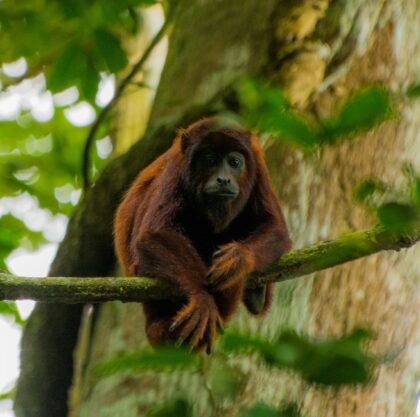In the heart of our jungle adventures, where the natural world weaves its stories, a curious chapter unfolded this month of September at the MLC – the tale of a Red Howler Monkey.
As part of the CREES Foundation’s educational programs, a group of enthusiastic students from a school in Salvation joined us, eager to learn about environmental education through the Teaching the Teachers of The Future initiative. As they were returning from a tropical ecology walk, they stumbled upon a Red Howler Monkey, only fifty metres away from the lodge, perched calmly on the middle of the forest trail.
This monkey, upon noticing them, retreated quietly, leaving us intrigued by that unusual behaviour. The following day, another staff member encountered the same monkey while he was doing laundry, this time slowly moving along the forest floor, just behind the public bathrooms.

The next day, during a peaceful morning, I was on duty helping prepare breakfast when I encountered the same monkey just three metres from the lodge’s entrance. It watched me with calm indifference, yet a prominent wound on its testicles suggested a deeper issue—the Red Howler Monkey was unwell, showing the presence of a significant injury, and struggling to ascend the towering trees of its jungle habitat.
Red Howler Monkeys, scientifically known as Alouatta sara, are sociable creatures often found in groups of 10 to 15. They lead unhurried lives, with limited daytime activity within small home ranges. Known for their unmistakable howling, these vocal performances extend for several minutes, especially during dawn, late afternoon, and rainstorms. Their diet primarily consists of leaves, with occasional additions of fruits, seeds, flowers, and stems. In terms of mating behaviour, male red howler monkeys engage in competition for access to females, sometimes resulting in confrontations or fights.
One plausible hypothesis for the monkey’s wound is that it may have been involved in a mating-related dispute with another male over access to a female. However, other factors, such as accidents or encounters with predators, could also lead to injuries. Following the encounter with the injured monkey, it gradually departed, never crossing paths with him again. We chose not to interfere with the natural wildlife cycle, acknowledging the inevitability of death as an integral part of the circle of life.
BSc Environmental Sciences – Blanca Ortiz Bocos – Conservation Intern
